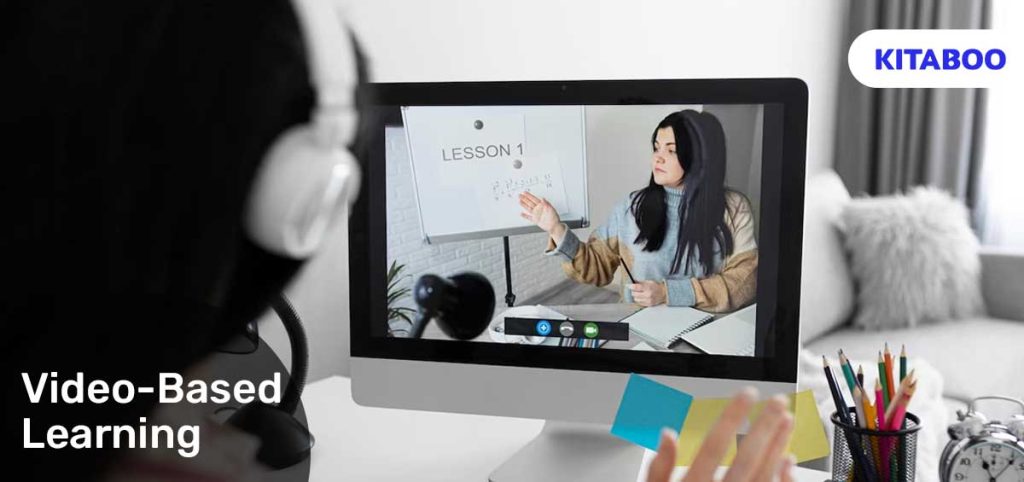
Creating Richer eLearning Experiences through Video-Based Learning
Summarize this blog with your favorite AI:
Here’s an interesting thought by Elon Musk that asks an essential question and stresses the impact of video-based learning. He said, “If kids can be super engaged in video games, there’s a way for them to be super engaged in education as well.” That’s like multiple chugging trains of thought going in the right direction.
Platforms like KITABOO have already enhanced the world of eBooks through AI by introducing tools like flashcards, chapter summaries, etc. Videos are the logical next step that can add to such eBooks and craft a revolution in the eLearning market.
Videos are the richest form of readily available media, including text, animations, voice-overs, music, camera footage, photographs, etc., which is why they are a no-brainer.
Video-based learning can increase student engagement and offer other benefits we’ll explore in this article. As per a study, 79% of students said they used videos to enhance their understanding of a topic. If you want to jump on the video-in-education bandwagon, keep reading.
Table of Contents
I. What is Video-Based Learning?
II. The Benefits of Video-Based Learning
- Richer, Stimulating Experiences
- Cost-Effective Teaching Method
- Facilitates Micro-Learning
- Allows Improved Accessibility
- Supports On-Demand Learning
III. How to Implement Video-Based Learning?
What is Video-Based Learning?
Video-based learning is when videos (live or pre-recorded) are used in learning modules (remote or blended learning). It offers a multi-sensory experience for different teaching methods and courses through multiple add-ons like text, audio, etc.
Examples of using videos for learning include animated explainers, tutorials, expert-led concept explainers, interactive videos, etc.
The Benefits of Video-Based Learning
There are many reasons why video is prevalent in education. Let’s take a look at some of the benefits.
1. Richer, Stimulating Experiences
As per recent studies, visual information from videos is processed 60,000 times faster than text by the human brain. This leads to better retention. It also simultaneously engages multiple senses, delivering a richer learning experience and making education more enjoyable.
This makes complex concepts easier to grasp as the brain uses more neural networks.
2. Cost-Effective Teaching Method
After a one-time cost is invested in adapting the course for video, other expenses like instructor fees are not recurring, mainly if it is recorded.
With the same video content, multiple students can learn over time. The one-time cost is also low with AI and numerous video production companies.
3. Facilitates Micro-Learning
4. Allows Improved Accessibility
With closed captions, voice-overs, the option to magnify the screen, adjust the speed at which it plays, etc., it caters to everyone. All students can learn at their own pace on their chosen device.
There are no geographical limitations, too, meaning someone sitting in one corner of Australia could learn from a video module from the US.
5. Supports On-Demand Learning
Anytime, anywhere should be the tagline for video-led learning. With wavering productivity and different preferred learning times during the day, video allows learning on the go and just in time.
The ability to rewatch lessons and revise the content from wherever they are also aids learning.
How to Implement Video-Based Learning?
If you want to upgrade your education courses with video, you can look at some of these suggestions:
- Choose which subjects could benefit through video.
- Start small and learn on the way.
- Set aside a budget to get these videos produced. Decide whether you want to do it in-house or outsource it.
- Keep the content simple and byte-sized.
- Use visuals, music, animations, etc., to increase engagement.
- Create effective communication channels for feedback and interaction with the instructor.
- Keep updating your videos to keep them relevant.
- Ensure it is optimized for multiple devices.
- Experiment with different video formats (animated videos, talking heads, slide-based videos, etc.)
- Think about localizing it for students who don’t speak the primary language used in the video. You can do so by dubbing over or using subtitles in different languages.
- Introduce gamification, scenario-based learning, question-embedding, etc. A study found that using question-embedded video-based learning tools increases students’ time spent with learning materials and promotes learning and interaction.
- If you want to understand the concept of using videos for learning deeper, understand these concepts:
- Cognitive load (using both the channels of working memory through a conversational way of talking, matching modality, and speaking with enthusiasm)
- Active learning (use guiding questions, use interactive methods of teaching
Case Study: Understanding the Impact
A case study was done to assess the results of using videos for learning during the pandemic at a university in Bangladesh. These are certain highlights:
- 39% of the students watched all the videos in the course
- 64.5% of students agreed that videos contributed to their learning experience greatly
- 60% of learners preferred teacher-made videos, while 39.5% preferred YouTube videos
- They asked for sound and visuals to be included in the video
- They asked for a good sound quality of the voice-overs and a higher resolution
- They wanted practical examples related to the study material
- Some of them asked for them to be in Bengali (the local language)
Video-Based Learning: What is the Future?
Video-based learning got its impetus from the pandemic. But it is here to stay, despite education returning to physical institutions. Organizations like Apple, Microsoft, and Google have entered the EdTech market, looking at how quickly it adapts to eLearning.
The introduction of Augmented Reality (AR) and Virtual Reality (VR) in learning through videos is predicted. It is also likely to become hyper-personalized with adaptive learning and AI-supported analytics. As its scope widens, we will also see an increased focus on privacy and security, along with other ethical considerations.
An increase in digital textbook platforms like KITABOO is also predicted to allow you to create, publish, and deliver multiple formats of content from one place and for various devices for eLearning.
However, videos may not completely replace in-person learning but instead give rise to hybrid education or blended learning to avoid passive learning or lack of interaction. Video-based learning is definitely the new normal.
Contact our expert team now and get started!
To know more, please write to us at contact@kitaboo.com.
Suggested Reads:
Discover how a mobile-first training platform can help your organization.
KITABOO is a cloud-based platform to create, deliver & track mobile-first interactive training content.



